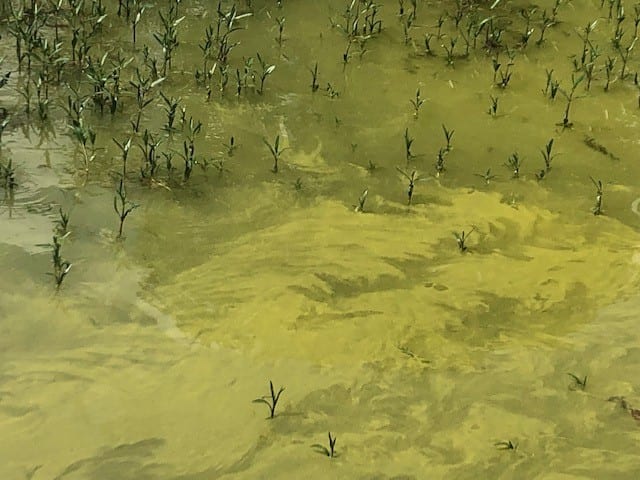Lake Maxinkuckee has had a long history of beautiful, crystal clear water. Perhaps that long history has made us take the water quality for granted.
Last week I was contacted by a concerned citizen asking about dead fish and “yucky green water” along the north shore. I responded by saying the dead fish are not unusual and that these hot, sunny days are conducive for explosions of algae growth. But then I was contacted by someone else on Thursday and someone else on Friday. I went to look for myself and was unpleasantly surprised. What I was seeing looked suspiciously like a blue-green algal bloom – which is NOT typical for Lake Maxinkuckee!
Algae is Everywhere – But Don’t Panic
Algae is naturally occurring in all waterbodies. There are numerous forms of algae, but one form, blue-green (also referred to as cyanobacteria) can produce toxins that affect humans and animals. Blue-green algae thrives in warm, still, shallow water – like what you will find along the shoreline. While blue-green algae are usually present throughout the year, they usually don’t cause problems until there’s an extensive “bloom.” And not all blue-green algae blooms produce toxins. Confused?
What Causes Blue-Green Algal Blooms?
There is no single factor that causes an algal bloom. A combination of factors such as excessive nutrients, warm temperatures, and lots of sunlight all encourage the growth of blue-green algae. The only factor we can control is limiting the excessive nutrients. I have written about it here and here and here and here. You can also find information about it on our website here.
Is the Water Safe?
There is no way to tell if the blue-green algal bloom is producing toxins just by looking at it. And there is no instant test. The only thing to do is gather a water sample and send it to a lab for analysis and wait for results. That is exactly what LMEF did last week. Unfortunately, the sample was collected on Saturday, the lab is closed on the weekend, so the sample was overnighted on Monday. I received the results on Wednesday morning – long after people had been in the water and the bloom was over. Not a very good system!
Do we need consistent lab testing for blue-green algae, like what the Parks Department does for E. coli at the public beach? I am not sure that is necessary, but it is worth a discussion. I am pleased that the Culver Parks Department and the Town of Culver is taking last week’s occurrence seriously. I have scheduled a conference call with the appropriate people to discuss this issue and decide how best to proceed. I believe at a minimum there needs to be informational signage at the park.
Can’t We Just Treat It to Make It Go Away?
Unfortunately, once there is an algae bloom, we can’t just treat the water to make it go away and declare the water safe. We have to wait until nature runs its course. The only thing we can do is limit our exposure to the toxins and wait until conditions improve.
Regardless of whether toxins are present or not, the protocol for swimming in freshwater lakes is the same:
- Don’t ingest the water
- Avoid contact with visible algae or algal scums
- Shower or bathe with warm, soapy water when you are finished
Because blue-green algae toxins can be fatal for dogs, if visible algae are present it is important to keep them out of the water. Details on what symptoms to track are provided on the BOAH Blue-Green Algae site.
Want more information?
How to identify blue-green algae and what to do about it (grace.edu)
IDEM: Blue-Green Algae: Home (in.gov)
Results of the Lab Analysis
“The potentially toxigenic (PTOX) cyantobacteria Microcystis sp. (>15 colonies per mL) were observed.”
According to the IDEM website, toxin exposure threshold for Microcystis:
Human Recreation Advisory – 8 colonies
Human Recreation Prohibited – 20 colonies
Dog Recreation Prohibited – .8 colonies

Hi, I’m Debbie Palmer. I received a BS in Horticulture from Purdue University. Here at LMEF, I am responsible for outreach presentations, monitoring the lake and it’s wetlands, project manager for restoration and research projects, and act as a community resource for all things related to the well-being of Lake Maxinkuckee and its surrounding watershed. I completed Indiana Watershed Leadership Academy, volunteer with the Indiana Clean Lakes Program, Hoosier River Watch and Marshall County Lakes and Waters and serve as a Board Member for Indiana Lakes Management Society.


Recent Comments